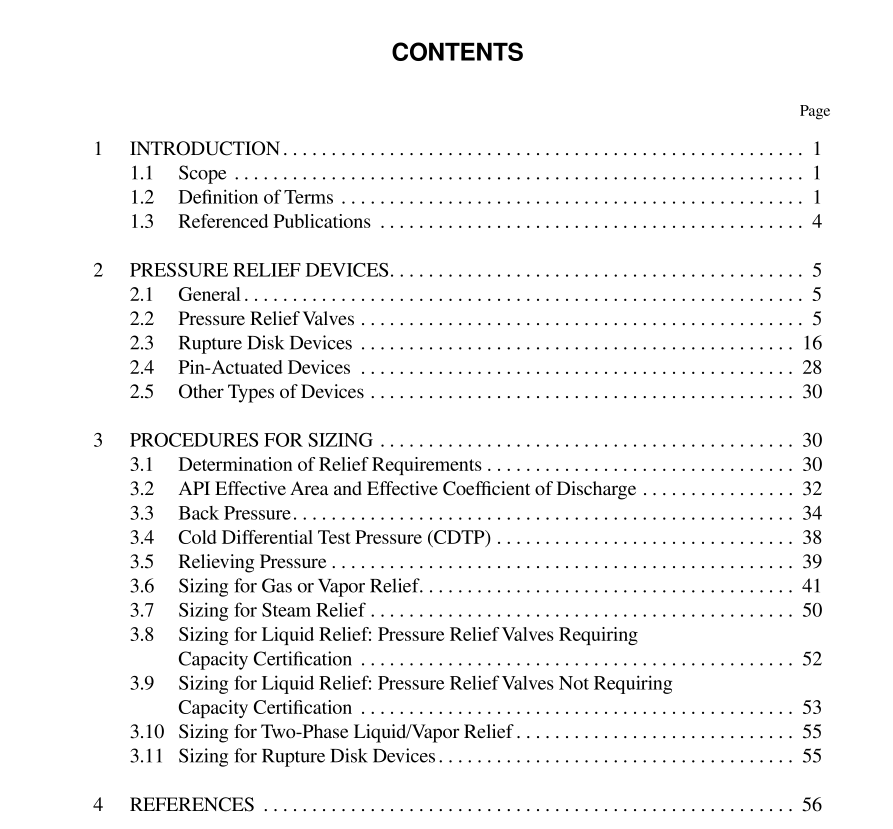API 520 PTI pdf download

API 520 PTI pdf download.Sizing, Selection, and Installation of Pressure-Relieving Devices in Refineries
1.1 SCOPE
This recommended practice applies to the sizing and selection of pressure relief devices used in refineries and related industries for equipment that has a maximum allow- able working pressure of 15 psig [103 kPag] or greater. The pressure relief devices covered in this recommended prac- tice are intended to protect unfired pressure vessels and related equipment against overpressure from operating and fire contingencies. This recommended practice includes basic definitions and information about the operational characteristics and applica- tions of various pressure relief devices. It also includes sizing procedures and methods based on steady state flow of Newto- nian fluids. Pressure relief devices protect a vessel against overpressure only; they do not protect against structural failure when the vessel is exposed to extremely high temperatures such as dur- ing a fire. See API Recommended Practice 521 for informa- tion about appropriate ways of reducing pressure and restricting heat input. Atmospheric and low pressure storage tanks covered in API Standard 2000 and pressure vessels used for the trans- portation of products in bulk or shipping containers are not within the scope of this recommended practice. The rules for overpressure protection of fired vessels are provided in Section I of the ASME Boiler and Pressure Vessel Code and ASME B31.1, and are not within the scope of this recommended practice.
1.2 DEFINITION OF TERMS
Terms used in this recommended practice relating to pres- sure relief devices and their dimensional and operational characteristics are defined in 1.2.1 through 1.2.3. The terms are covered more specifically in the applicable sections of text and accompanying illustrations. 1.2.1 Pressure Relief Devices 1.2.1.1 pressure relief device: Actuated by inlet static pressure and designed to open during emergency or abnormal conditions to prevent a rise of internal fluid pressure in excess of a specified design value. The device also may be designed to prevent excessive internal vacuum. The device may be a pressure relief valve, a non-reclosing pressure relief device, or a vacuum relief valve.1.2.1.2 pressure relief valve: A pressure relief device designed to open and relieve excess pressure and to reclose and prevent the further flow of fluid after normal conditions have been restored. a. A relief valve is a spring loaded pressure relief valve actu- ated by the static pressure upstream of the valve. The valve opens normally in proportion to the pressure increase over the opening pressure. A relief valve is used primarily with incom- pressible fluids. b. A safety valve is a spring loaded pressure relief valve actu- ated by the static pressure upstream of the valve and characterized by rapid opening or pop action. A safety valve is normally used with compressible fluids. c. A safety relief valve is a spring loaded pressure relief valve that may be used as either a safety or relief valve depending on the application. d. A conventional pressure relief valve is a spring loaded pressure relief valve whose operational characteristics are directly affected by changes in the back pressure. e. A balanced pressure relief valve is a spring loaded pres- sure relief valve that incorporates a bellows or other means for minimizing the effect of back pressure on the operational characteristics of the valve f. A pilot operated pressure relief valve is a pressure relief valve in which the major relieving device or main valve is combined with and controlled by a self actuated auxiliary pressure relief valve (pilot).1.2.1.3 non-reclosing pressure relief device: A pressure relief device which remains open after operation. A manual resetting means may be provided. 1.2.1.4 rupture disk device: A non-reclosing pressure relief device actuated by static differential pressure between the inlet and outlet of the device and designed to function by the bursting of a rupture disk. A rupture disk device includes a rupture disk and a rupture disk holder.









